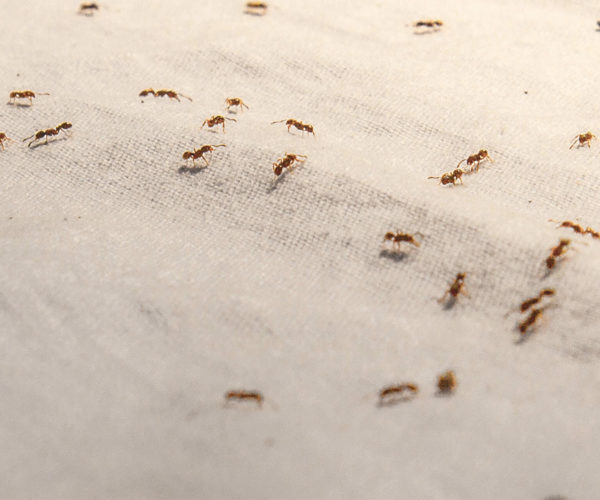As a business owner, you are responsible for the safety of your employees. This is particularly important in the extermination industry, due to the potential for interactions with insects that could cause a great deal of pain or even complications. Familiarize yourself with the insect pain index, as well as why you should be aware of it and how to help protect your exterminators from painful stings and bites.
What Is the Insect Pain Index?
The insect pain index is a common name for the Schmidt Sting Pain Index. Entomologist Justin O. Schmidt created this index. It was the result of spending more than a decade being purposely stung and bitten by bugs, then describing the pain and experience.
His interest in the index began from Schmidt’s specialization in hymenopterans, which include wasps, bees, their cousins, and ants. Schmidt noticed that he would regularly have to deal with painful defensive maneuvers, jabs, and pinches, and he became interested in the differences.
The insect pain index includes a scale with more than 70 stings. Each is given a rating of between 1 and 4 to represent stings that range from irritating to excruciating.
To provide you with an example of the types of ratings and descriptions you will find on the Schmidt sting pain index, consider the following insects.
Bullet Ant: 4.0+
The bullet ant is native to exotic tropical locations in South and Central America, and this large black ant has painful stings that are off the charts. According to Schmidt, the sting is incapacitating, as it remains intense for a minimum of 12 hours and frequently as long as 24 hours. Schmidt famously compared the pain to fire-walking over charcoals while a rusty nail is in your heel.
Paper Wasp: 3.0
Paper wasps are fairly common and found by porch areas and under eaves. The pain is burning and caustic with an aftertaste that is distinctly bitter. The only good side is that the pain starts to fade after around 15 minutes.
Red Harvester Ant: 3.0
The red harvest ant is mostly found in Arizona and New Mexico, and Schmidt compares their sting to excavating an ingrown toenail with a drill.
Yellow Jacket: 2.0
The pain of a yellow jacket sting can last as long as 10 minutes. Schmidt’s description compares it to extinguishing a cigar on the tongue.
Fire Ant: 1.2
Schmidt’s pain rating for fire ant stings assumes you just get stung by one, not a swarm. He describes it as mildly alarming and sudden.
Sweat Bee: 1.0
These bees in the Halictidae family are attracted to perspiration. They do not sting often, but when they do, they get the lowest possible pain rating from Schmidt.
General Findings
In general, Schmidt noticed that the higher risk there is to a colony correlates to an increase in pain and greater toxicity of the venom. Risk factors include the threat of predation and the number of individuals in the colony. As such, Schmidt was unsurprised to rate bullet ants as among the most painful.
Schmidt also noted in his pain index that the variations in pain levels are largely due to the unique chemical formulas of each venom. For example, wasps have kinins, which are similar to a natural cardiac stimulant the body makes, while honeybees have melittin, a peptide.
Why Business Owners Need to Be Aware of It
As a business owner, you should be aware of the most painful sting your exterminators will likely receive as well as the pain from other stinging insects. After all, you do not want your exterminators to be in unnecessary pain, yet you want them to understand the types of pain that they may experience while working.
When your exterminators are in pain, they will be unlikely to be able to work as efficiently, hurting your bottom line. In the case of certain insects, there is also a risk that the sting will be intense enough to put them out of work for a short period. Not only is that a financial blow to your business, but it also can hurt morale. After all, it would be hard to keep employees motivated if they have to deal with the constant fear of stings, including a 4.0 on the sting pain index.
The opposite is also true. By being aware of the insect pain index and taking steps to minimize the risk to your exterminators, you can boost morale. You will be treating them as valued employees and showing that you care that they are not in pain, which should encourage them to work harder and more effectively.
While there are certainly dozens of insects on the sting pain scale that your exterminators are unlikely to encounter due to their geographic location, it is best to be prepared.
How to Protect Your Exterminators
So, how do you protect your exterminators from stings? Take basic precautions, such as using protective gear. Ensure your exterminators are not only protected but also easily communicating with Podium, so they can report stings and anything unusual.
Your exterminators should start with basic precautions and training on taking the appropriate actions while near insects, especially those that are higher on the insect pain index. They should wear long sleeves and long pants while at work to cover more exposed skin and avoid using products that have strong perfumes, as those may attract insects.
One of the most important ways to protect your exterminators from these stinging bites is to train them properly. Before you send them out to clients, ensure they are aware of the safety precautions they should take.
Teach Them What to Do After a Bite
In this line of work, you can reduce the risk of an insect bite, but you are unlikely to eliminate it. Because of this, ensure that your training for exterminators includes what to do after being bitten by an insect. Let them know to remove the stinger (if applicable), wash the area, and apply a cool compress. Suggest keeping a 0.5 to 1 percent hydrocortisone cream on hand to apply to the bites.



